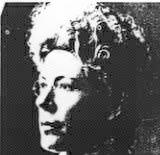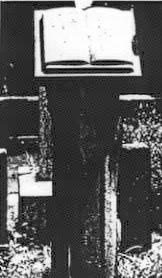Direct Support Missions
(Christian churches and churches of Christ)
Belle Bennett, daughter of missionaries serving in Australia, died in a boating accident in the Des Moines river the day before she was to go to Japan as a missionary. This was 1889. The students of Drake University, Des Moines, Iowa, raised $4000 in her memory and asked for a missionary volunteer to go in Miss Bennett's place.
Loduska J. Wirick answered that call. She came to Japan in the summer of 1890. To her regret, the FCMS retained control of the memorial fund for five years. It was only after that time that she was able to receive the proceeds directly and become truly independent.

Loduska Wirick
So it can be truly said that Miss Wirick was the first independent missionary of our people. She served nobly in Japan, particularly in her service to many Japanese soldiers wounded in the war with Russia and brought back to Japan for treatment. For this work she became known as the "Nightingale of the Orient."
She was on furlough in Iowa when an examination at the Mayo Clinic revealed she had cancer. She immediately said good-bye to her aging mother and returned to Japan to finish up her work and die here-- April 30, 1914. Her grave has an unusual gravestone - a pulpit with an open Bible resting on it with the inscription from Hebrews 11:4, "Being dead - yet speaketh." It deserves to be visited by every missionary. She is buried in Somei Cemetery, Toshima-ku, in northern Tokyo.

Miss Wirick's grave
It was W.D. Cunningham who made independent missions the standard for missionary outreach of "the Centrists". Born July 19, 1864 in Dawson, Pennsylvania, he graduated from Bethany College and had successful ministries in Canada. After he married Emily Boyd in June, 1898, they applied to the FCMS to work in Japan with C.E. Garst.
They were ready to go when Cunningham came down with polio. His left side was greatly affected. After he recovered, he applied to the FCMS again. They said to wait a year. Again he applied and again he was refused. In April, 1900 he received the final rejection by the FCMS. As he was asking himself, "Why?", his mind leaped to a great truth: "God and the Missionary Society were not identical. Since God called, he could answer, depending on God, who is more powerful than any society. He would go to Japan. He would go at once. He would answer God's call. He need wait no longer - - - (The Flaming Torch, 1939, p.28)
His wife agreed with him that they would go to Japan on faith. They arrived in Tokyo, September 12, 1901, bringing with them their three-year-old daughter, Eloise. (Eloise Cunningham is still living in Tokyo, active in music circles, but out of touch and out of harmony with her parents' successors.)
Cunningham immediately began to earn a living teaching English. In his mission work, however, he did not start from scratch. He acquired the property and the eleven-year-old work of Alice Miller, Lucia Scott and Carme Hostetter known as the Yotsuya Mission. This was and is a strategic piece of property. He built a house and a church on the land, and the Cunningham mission began.
Cunningham was 37 years old when he came to Japan, but he plunged into his work with energy and dynamism. He was a rugged individualist. This might be best illustrated by what he wrote to Alva Ross Brown, then President of Johnson Bible College, asking him to serve on the mission's Advisory Board. He said, "Unless you survive the writer, your duties will be to give counsel when asked." Another advisor, W.R. Walker, did not recall ever being asked.
Through his superb promotional ideas, he built the Yotsuya work into one of the biggest independent missionary works our people ever had. In 1926 the mission had receipts of $77,235.60 and was praying to receive $165,000 a year. Translated into today's sums that would equal a million dollars. Amazing! He wanted to employ workers costing $50,000 a year, invest $100,000 in land and buildings and another $15,000 in furnishings and equipment.
That pointed up the weakness of Cunningham's work. Everyone was "hired". National preachers, most with denominational backgrounds, were employed. They had to assemble every Monday morning and give a numerical report of their last week's activities.
Even the missionaries were hired. It is significant that Grace Farnham was the only missionary to stay long enough to earn a furlough but she resigned soon after she returned to Japan. M/M J. Fenton Messenger also served a full term but resigned before leaving for furlough.
In 1922 the mission had 6 churches, 8 out-stations and a training class for ministers conducted in two out-stations. But Cunningham never tried to start a Bible college to train his own men. In October, 1924, he sent his best man, Li Wan Kyun to begin a work in Korea, the first work done in that country by Churches of Christ. The work was successful and was Cunningham's pride and joy.
Then the Depression hit. Income fell two-thirds. Out-stations began to close. John Chase approached Mr. Cunningham and asked for a raise, saying he was not getting enough to live on. Cunningham refused. Chase took his case to the brotherhood papers including Cunningham's own Tokyo Christian. In October, 1934, Cunningham called Chase over to his house, met him at the door and said, "You're fired."
That was the zenith of the Cunningham work. Chase left Japan and returned in 1936 to do an outstanding work in Korea. Vivian Lemmon, Grace Farnham and Ruth Schoonover resigned in protest and the Cunninghams were left to carry on alone temporarily. The three ladies began a mission work in Mabashi, Tokyo, November 11, 1934. Grace Farnham is retired, living in Turner, Oregon. Ruth Schoonover died in Tanabe where she was starting a work. After a number of years in the U.S. taking care of her aging father, Vivian Lemmon returned in 1950 to do a very successful work in Tanabe, south of Osaka, where she still lives. She is the grand old lady of our people in Japan, loved and respected by all.
While on furlough, Mr. Cunningham died quite suddenly in Rochester, Minnesota, June 24, 1936. Mrs. Cunningham returned to carry on the work alone. Through the good offices of Judge Hathcock of Atlanta, Georgia, she was able to recruit M/M Owen Still to come and assist her.
They arrived on the Taiyo Maru, that venerable passenger ship which carried so many hundreds of missionaries to Japan in her day. The Stills lived with Mrs. Cunningham briefly, then in Shibuya before settling in Higashi Nakano. In late 1940 the family returned to the U.S. as the shadow of war began to fall. Mrs. Cunningham was repatriated on the Gripsholm in June, 1942 and Grace Farnham, in September, 1943 on the same ship. She was the last of our missionaries to return.
No list of pioneer independent missions would be complete without mentioning M/M M.B. Madden. They came to Japan first in 1895 with the FCMS. Mr. Madden was a short man and could be mistaken for a Japanese. He mastered the language and evangelized tirelessly. Mrs. Madden was his equal in talent. Few people have written so carefully and beautifully about Japan as she. In addition to many articles published in The Lookout she has 10 published books to her credit, the most famous of which is In the Land of the Cherry Blossoms.
In 1914 M.B. Madden resigned from the FCMS because of their autocratic methods. Particularly, he objected to being moved around so much and for their failure to back a policy of self-support among the Japanese churches.
The Maddens returned to Japan as independent missionaries in 1919, settling in the Temmabashi district of Osaka. They rented property there and began a church and kindergarten. This property was damaged by the Muroto Typhoon of 1934. The Maddens tried to buy this property from the owner but he would not sell. They then bought the property in Asahi-ku where Osaka Bible Seminary now stands. Both Mr. & Mrs. Madden had a vision of starting a Bible college to train preachers. They invited M/M Harold Cole to come to Japan for that purpose.
Harold Cole began the classes of Osaka Bible Seminary in April, 1937. The school continued until ended by the war in May, 1941.
The Madden's daughter, Grace, was also in Osaka at the same time in charge of kindergarten work. She married Gerald Braley, then employed by The Mainichi newspaper. Both of them taught classes in the English night school.